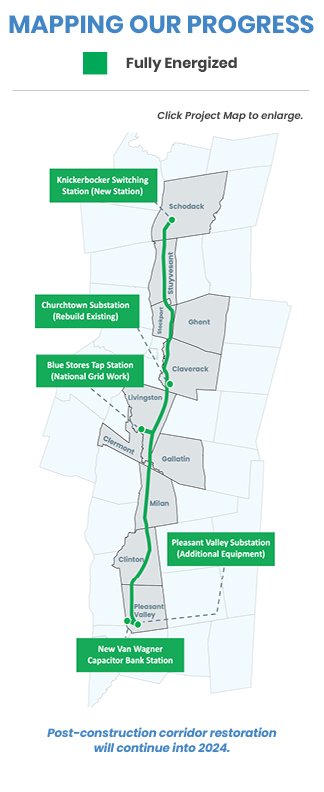NYES Will Improve Electricity Flow & Reliability, Opening Pathways For Renewable Energy
New York State has long been faced with energy challenges.
The state’s aging electric transmission system becomes congested and inefficient in delivering power. This increases costs to homes and businesses and limits the flow of clean, renewable energy that is being produced in Northern New York.
New York Energy Solution (NYES) is an innovative, community-focused project to address these issues and create a brighter energy future. Construction began in 2021 and will continue into 2023.
View our Project Fact Sheet here.
Minimizing Costs, Maximizing Benefits
The NYES project will:
Modernize aging infrastructure, replacing equipment that was installed as much as 80 years ago.
Be built entirely within the existing utility-owned corridor and on utility-owned land.
Reduce the number of structures in the corridor by approx. 230.
Alleviate energy bottlenecks, allowing for the efficient flow of clean energy from Upstate New York in support of the New York State Climate Leadership and Community Protection Act, which mandates that 70% of New York State’s electricity to come from renewable sources by 2030.
Improve the reliability and resiliency of the transmission system, particularly during severe storm events.
Generate additional annual tax revenue for host communities and provide local jobs during the approximately two-year construction period.
In addition, NYISO determined NYES would have the lowest cost per megawatt generated, and the greatest reductions in carbon dioxide generation of all the proposals submitted.
Project Details
Our upgrades are taking place entirely within a 54-mile existing utility corridor and on utility-owned lands in the towns of Schodack, Stuyvesant, Stockport, Ghent, Claverack, Livingston, Gallatin, Clermont, Milan, Clinton, and Pleasant Valley. When complete in 2023, there will be approximately 230 fewer transmission structures in the corridor than there are today.
+ Click here for details of the Schodack to Claverack portion of our project.
Betwee Schodack and Claverack, we will:
• Build a new 345 kV switching station on utility-owned land in Schodack;
• Remove 80-year-old lattice transmission structures along approximately 22 miles of the existing utility corridor;
• Install new, double circuit monopole transmission structures, with an average height increase of 10 feet, that will carry an existing 115 kV line and a new 345 kV line. One existing 115 kV transmission line will be permanently retired.
+ Click here for details of the Claverack to Pleasant Valley portion of our project.
Between Claverack and Pleasant Valley, we will:
• Rebuild an existing switching station on utility-owned property in Claverack;
• Remove 80-year-old lattice transmission structures, which sit in side-by-side pairs along approximately 32 miles of the existing utility corridor;
• Install a single row of new, double circuit monopole transmission structures, with an average height increase of 10 feet, to carry a new 345 kV line and one existing 115 kV line. Three existing 115 kV lines will be removed;
• Upgrade one existing section of the 2.2-mile Blue Stores tap line in the Town of Livingston, replacing the existing H-frame structures with an equal number of new H-frame structures with an average height increase of 15 feet. The existing 115 kV line will remain on the new structures;
• Construct a capacitor bank station and supporting infrastructure on utility-owned property off Van Wagner Road, approximately 0.8 miles northwest of the Pleasant Valley Substation. This location is adjacent to an existing utility corridor (different corridor from the other NYES work). Two existing lattice transmission structures in this corridor will be replaced by four H-frame structures approximately 95 feet tall, which is similar height to nearby structures and 45 feet lower than the tallest existing structures that will remain in the corridor. Other lattice structures currently in the corridor will remain, but new wire or conductor will be strung on these existing structures. This work is called a reconductoring. Like all of our project, this work will take place entirely within existing utility corridors and on utility-owned property. Please note: This is a change from the original project design, made to reduce impacts, respond to local stakeholder feedback and to streamline construction processes.
Project Timeline
2019-2021: Permitting
2021-2023: Construction
End of 2023: Project complete, improved transmission infrastructure in service.
Spring 2024: Restoration complete
Our Commitment to Public Engagement
NYES is committed to stakeholder engagement through the duration of the project. We have hosted or participated in a large number of group and individual meetings in towns along the project route, and will continue to work closely with community leaders and other interested parties, regulatory agencies, and individual property owners and residents throughout the permitting and construction phases. A full report on our community and stakeholder outreach activities can be found here.
If you have questions about our work, please don’t hesitate to contact us at info@ny-es.com or toll-free at 1-800-897-0179. Someone will respond to your inquiry within 24 hours.


